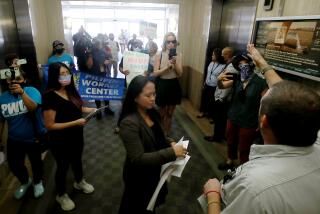Group to file complaint against Cal/OSHA over staffing levels
SACRAMENTO — The health and safety of California workers are being threatened because of an inadequate number of state workplace inspectors, a new report says.
Public Employees for Environmental Responsibility, a nonprofit whistle-blower group in Washington, says it plans Tuesday to file a formal complaint with the U.S. Occupational Safety & Health Administration, contending that California’s version of the agency no longer meets minimum standards.
The complaint is based on a new report analyzing staffing at the California Division of Occupational Safety & Health, known as Cal/OSHA, that found that the state has fewer workplace inspectors than a quarter-century ago.
At the end of 2013, California had 170 inspectors, said the report written by a former Cal-OSHA employee. That’s down 8% from 1989 totals, when the state had far fewer workers, and 11% less than in 2011, when Democratic Gov. Jerry Brown replaced Republican Gov. Arnold Schwarzenegger.
As a result, California has just one inspector for every 109,000 workers, compared with a ratio of 1 to 66,000 in states where the federal government is responsible for job site safety.
But the state disputes the report’s estimate of 170 inspectors. Christine Baker, director of the California Department of Industrial Relations, which oversees the safety agency, said the state has 182 inspectors and is adding 41 more after July 1 as part of a restructuring.
But Garrett Brown, who wrote the report and recently retired from Cal-OSHA after 20 years with the agency, is skeptical. “Staffing levels are dangerously low,” he warned in the report.
“Not having enough compliance inspectors means that Cal-OSHA is not able to respond to worker complaints in the time period Fed-OSHA wants us to,” he said.
The report said a high ratio of workers to inspectors often means inspectors are too busy to spot work-site dangers before they cause serious injuries or deaths, experts say.
Hundreds of Californians are killed on the job each year and tens of thousands are hurt, according to government statistics compiled by advocacy groups.
Indeed, there’s plenty that needs fixing at Cal-OSHA, said Baker, the state’s industrial relations director, but improvements are in the works.
Brown’s plan to increase staffing is an opening move in “bringing Cal-OSHA into the 21st century,” she said. More manpower is just part of an initiative that includes developing a new strategic plan, boosting infrastructure and modernizing management.
An increased budget for the 2014-15 spending year will enable Cal-OSHA to access more resources, including federal funds and employer fees, she said.
Although the number of investigations opened by Cal-OSHA has been fairly steady over the last two decades, total on-site inspections dropped to fewer than 8,000 a year in 2011 and 2012 from an average of about 9,000 to 10,000 a year to from 1992 to 2002, according to Cal-OSHA statistics released last week.
The number of workplace violations issued by the agency has also declined to 15,000 in 2012, the most recent full-year figures, from more than 20,000 violations cited each year in the 1990s and early 2000s.
The number of “serious” citations, which refer to problems at a workplace that pose a danger to worker’s safety and can carry heavier fines and penalties to encourage compliance, fell to 2,700 in 2012 from 4,000 to 7000 a year in the 1990s and most of the 2000s, according to Cal-OSHA.
Labor unions and work-site safety proponents said a shortage of inspectors leaves safety agencies unaware of potential problems.
“There’s no ability for regulators to keep tabs on what’s going on in an industry,” said Kim Nibarger, a health and safety specialist with the United Steelworkers, which represents refinery employees and many other workers.
He recalled how a series of accidents at a Tosco Corp. oil refinery in the San Francisco Bay Area in the late 1990s killed six people and injured more than 40 others. About a dozen heat-related deaths have claimed farmworkers since 2005.
More inspectors “would make our fields safer places to work and help prevent needless death and injury,” said Hernan Vera, president of Public Counsel, a public interest law firm that is representing the United Farm Workers in a heat-illness-related lawsuit against Cal-OSHA.
“Employers are responsible for providing a safe place to work. And it’s the government’s job to make sure they do it,” said Gail Bateson, executive director of the advocacy group Worksafe. “With the current level of resources, the agency is not able to do what it’s supposed to do.”
Twitter: @MarcLifsher
Twitter: @latimesjessicag
More to Read
Inside the business of entertainment
The Wide Shot brings you news, analysis and insights on everything from streaming wars to production — and what it all means for the future.
You may occasionally receive promotional content from the Los Angeles Times.







